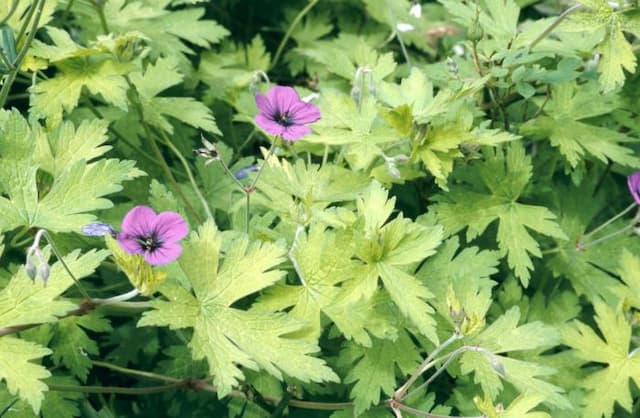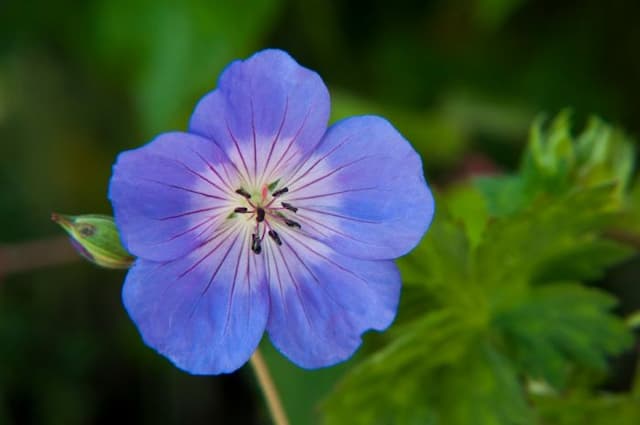Sarita Geranium Geranium × monacense

ABOUT
The plant commonly known as the cranesbill geranium or garden geranium is characterized by its attractive foliage and flowers. The leaves are often rounded or palmately lobed, creating a lush, dense canopy of greenery. Depending on the variety, the foliage might also have interesting patterns or tints of color. The flowers are perhaps the most striking feature of the cranesbill geranium, with their distinctive five-petaled shape. They come in a palette of colors ranging from white to pink, purple, or blue, often with prominent veining or eye-catching darker markings that can add to their ornamental appeal. These blooms are usually arranged in loose clusters, giving the plant a delicate and somewhat whimsical presence in the garden. This variety of geranium is also appreciated for its hardiness and its ability to adapt to a wide range of environmental conditions, often thriving where other plants might struggle. The overall impression of a cranesbill geranium plant is one of cheerful robustness, with a profusion of flowers that can enliven a garden space throughout its blooming season.
About this plant
 Names
NamesSynonyms
Munich Storksbill
Common names
Geranium x monacense.
 Toxicity
ToxicityTo humans
Geranium × monacense, commonly known as a type of cranesbill geranium, is not known to be toxic to humans. The plant does not produce harmful toxins that affect human health, and there are no widely recognized symptoms of poisoning from ingesting cranesbill geranium. However, as with any plant, individuals may have unique sensitivities or allergies that could result in mild reactions, but these are not common.
To pets
Cranesbill geranium is not known to be toxic to pets. There is no evidence to suggest that Geranium × monacense poses any significant risk of poisoning to animals such as dogs and cats. The ingestion of this plant is not commonly associated with any serious health consequences or symptoms of poisoning in pets. However, it is always prudent to monitor your pet and consult with a veterinarian if any unusual behavior or symptoms arise after ingestion of any plant material.
 Characteristics
CharacteristicsLife cycle
Perennials
Foliage type
Deciduous
Color of leaves
Green
Flower color
Mixed
Height
1-2 feet (30-60 cm)
Spread
1-2 feet (30-60 cm)
Plant type
Herb
Hardiness zones
5
Native area
Europe
Benefits
 General Benefits
General Benefits- Aesthetic Appeal: Geranium × monacense, commonly known as Hardy Geranium, adds visual interest to gardens with its attractive foliage and colorful flowers.
- Drought Resistant: Being drought-tolerant, it requires less watering and maintenance, making it suitable for xeriscaping and low-water gardens.
- Pest Resistant: Hardy Geraniums are resistant to many common garden pests, reducing the need for chemical pesticides.
- Wildlife Attraction: The flowers of the Hardy Geranium attract beneficial pollinators, such as bees and butterflies, supporting local ecosystems.
- Ground Cover: With its spreading habit, it can serve as an effective ground cover, reducing soil erosion and suppressing weeds.
 Medical Properties
Medical PropertiesThis plant is not used for medical purposes.
 Air-purifying Qualities
Air-purifying QualitiesThis plant is not specifically known for air purifying qualities.
 Other Uses
Other Uses- Geranium × monacense, commonly known as Cranesbill, can be used as a natural dye source, providing a range of colors from greens to browns depending on the mordant used.
- The leaves of the Cranesbill can be pressed and used in the art of flower pressing to create decorative pieces or to preserve the beauty of the plant in crafts.
- Its scented foliage can act as a mild natural insect repellent when planted in gardens or when the leaves are strewn in areas where pests are unwanted.
- Cranesbill can be planted in outdoor pet areas as a non-toxic plant option that is safe for dogs and cats to be around.
- The flowers can be used in culinary applications, such as salad garnishes, for a splash of color and subtle flavor enhancement.
- The dried petals of Cranesbill can be used in potpourri mixes to add a gentle fragrance to your home environment.
- This plant can be integrated into educational activities for children, teaching them about pollination as it attracts bees and butterflies.
- As a source of nectar, Cranesbill can contribute to home-based honey production by providing bees with a rich foraging plant.
- The robust nature of Cranesbill makes it a suitable plant for erosion control on slopes and banks, where it can help to stabilize the soil with its root system.
- Gardeners can use Cranesbill in companion planting to enhance the growth and health of vegetables such as tomatoes, by providing ground cover and attracting beneficial insects.
Interesting Facts
 Feng Shui
Feng ShuiThe plant Geranium is not used in Feng Shui practice.
 Zodiac Sign Compitability
Zodiac Sign CompitabilityThe plant Geranium is not used in astrology practice.
 Plant Symbolism
Plant Symbolism- Protection: Geraniums are often associated with safeguarding against negativity and promoting a sense of safety.
- Friendship: Gifting geraniums can be a sign of deep friendship or a way to foster new relationships.
- Health: Some believe geraniums can symbolize a wish for good health and positive well-being.
- Fertility: Given their robust growth and abundant flowers, geraniums can sometimes represent fertility or creation.
- Happiness: The bright and cheerful flowers of geraniums often symbolize happiness and joyful times.
 Water
WaterThe Cranesbill, commonly known as Geranium × monacense, should be watered deeply and thoroughly to encourage root growth. Water the plant when the top inch of soil feels dry, typically once a week, but this frequency may need to increase during hot, dry spells. It is best to water early in the morning to reduce evaporation and prevent fungal diseases. Avoid overhead watering to keep the foliage dry, and aim to apply about 1 gallon of water per square foot every week during the growing season, adjusting based on weather conditions and soil type.
 Light
LightCranesbill thrives in full sun to partial shade. The ideal location offers morning sunlight and afternoon shade, especially in regions with hot summers. If grown indoors, place it near a south or east-facing window where it will receive ample bright, indirect light for the majority of the day.
 Temperature
TemperatureCranesbill plants prefer temperate conditions and grow best when daytime temperatures range between 65°F and 75°F. They can survive minimum temperatures down to around 20°F but should be protected from frost. The ideal growth range is above the freezing point and below 85°F for optimal health and flowering.
 Pruning
PruningPruning Cranesbill, or Geranium × monacense, is done to promote bushier growth, remove spent flowers, and maintain an attractive shape. Prune the plant in early spring to remove any dead or damaged growth, and deadhead regularly by removing spent blooms. Major pruning should be performed immediately after flowering to rejuvenate the plant for the next season, as Cranesbill typically flowers once annually.
 Cleaning
CleaningAs needed
 Soil
SoilThe Monkshood Geranium thrives in well-draining, fertile soil with a pH range of 5.8 to 6.3. A mix of equal parts garden soil, peat, and perlite or coarse sand works well to ensure proper drainage and aeration. Regularly adding organic matter can help to maintain soil richness and structure beneficial for this geranium species.
 Repotting
RepottingMonkshood Geraniums should be repotted every one to two years, or when they outgrow their current container. This will provide them with fresh soil and more room for root growth, which is essential for their continued health and flowering.
 Humidity & Misting
Humidity & MistingMonkshood Geraniums prefer moderate humidity levels. To ensure they thrive, aim for a humidity level around 50-60%. These geraniums are fairly adaptable but avoid placing them in overly dry or highly humid environments as this can stress the plant.
 Suitable locations
Suitable locationsIndoor
Place in bright, indirect light and ensure good airflow.
Outdoor
Choose a spot with morning sun and afternoon shade.
Hardiness zone
4-8 USDA
 Life cycle
Life cycleGeranium × monacense, commonly known as cranesbill or hardy geranium, begins its life cycle as a seed, typically dispersed by wind or animals in late summer or fall. Upon finding a suitable location with enough warmth and moisture, the seed germinates in the spring, producing a small seedling which then develops a root system and foliage through the process of photosynthesis. Throughout the spring and summer, the cranesbill grows rapidly, forming a rosette of leaves at its base, and lengthens its stems to prepare for flowering. Flowers appear in late spring to early summer, showcasing five-petaled blooms that attract pollinators important for the plant's sexual reproduction. After pollination, the flowers develop into beak-shaped seed capsules that burst open when ripe to disperse seeds, ensuring the next generation. During fall, the plant begins to die back, with the above-ground foliage withering away, while the rootstock or tuber remains dormant underground through the winter, ready to restart the cycle in spring.
 Propogation
PropogationPropogation time
Spring-Early Summer
Geranium × monacense, commonly known as the Hardy Geranium or Cranesbill, is often propagated through division, which is considered the most popular method for this perennial plant. This process is typically best performed in either spring or early fall when the weather is cool and the plant is not in full bloom. To propagate by division, the gardener should carefully dig up the plant, ensuring to get as much of the root system as possible. The clump is then gently pulled apart into smaller sections, each with several shoots and a portion of the root system. These new divisions can then be replanted into prepared soil, spaced approximately 12 to 18 inches (30 to 45 centimeters) apart, and watered well to establish them. Through division, the Hardy Geranium can be efficiently multiplied, maintaining the health and vigor of the parent plant, while quickly filling garden spaces with new plants.









